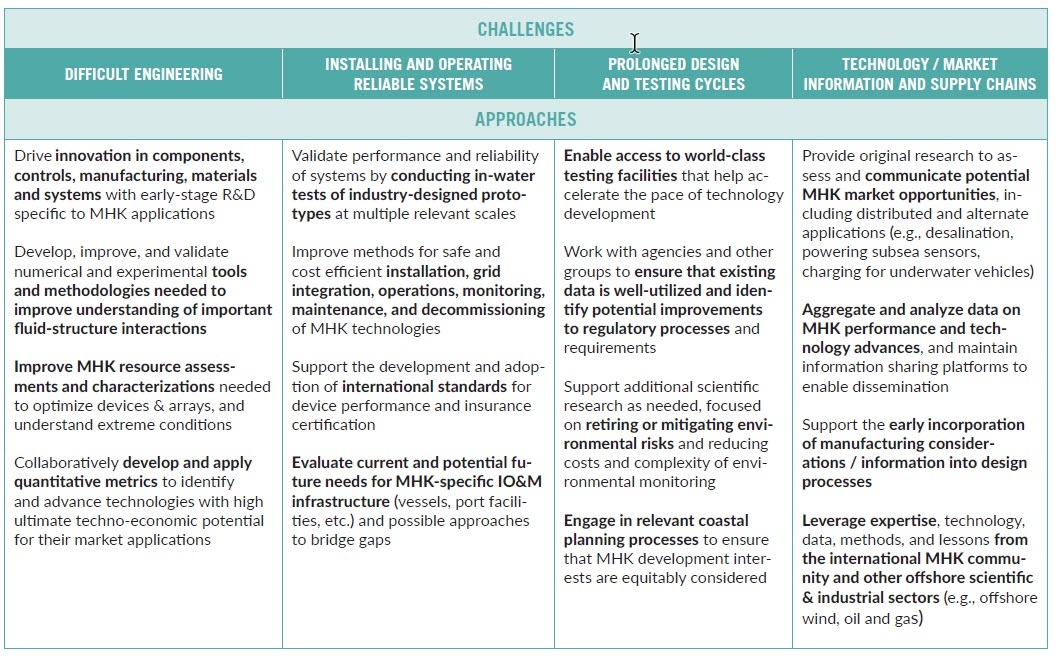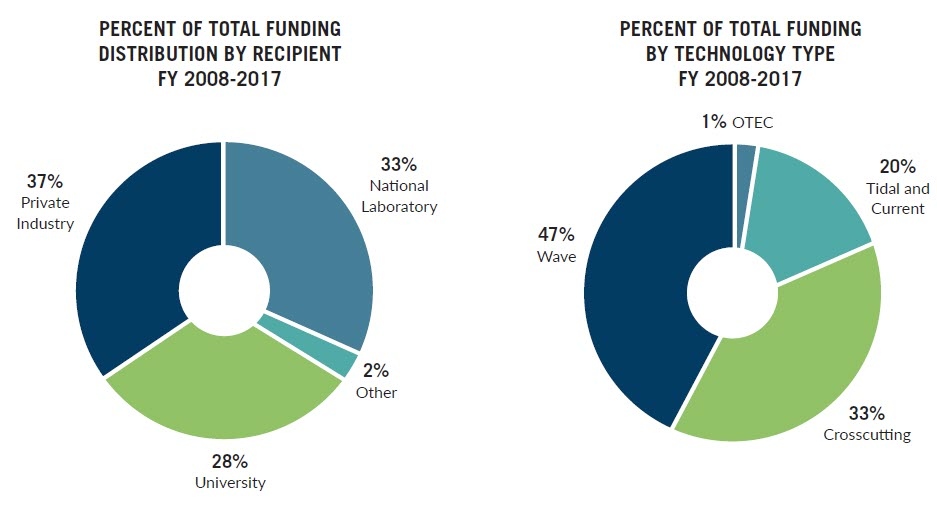UNITED STATES OF AMERICA
SUPPORTING POLICIES FOR OCEAN ENERGY
NATIONAL STRATEGY
In 2017, the U.S. Department of Energy (DOE) Water Power Technologies Office’s (WPTO) Marine and Hydrokinetic Program solicited a second request for information from stakeholders to refine the draft National Strategy for Marine and Hydrokinetics. This Strategy has been developed and refined through multiple rounds of feedback and discussion with industry, academia, government staff, and other stakeholders. The WPTO Strategy nominally covers the time-period from present to 2035, but it is intended to be updated every 4-5 years to reflect changes in research needs, priorities, and challenges faced by the industry.
In its current form the draft WPTO Strategy consists of a vision, DOE-centric mission, set of core challenges that currently inhibit the development of the U.S marine renewable energy industry, and various approaches that the Department believes are necessary to address the challenges. An overview of the draft WPTO strategy is presented below.
Currently, the vision identified in the Strategy is for “A U.S. Marine and Hydrokinetic (MHK) industry that expands and diversifies the nation’s energy portfolio by responsibly delivering power from ocean and river resources”. The WPTO mission that supports this vision is to “Conduct early-stage research to further the development of transformative, reliable, and cost-competitive MHK technologies and reduce critical deployment barriers.”
The draft Strategy identifies four main challenges facing the marine renewable energy industry. These challenges include:
- the unique and complex engineering issues faced in designing devices that can efficiently convert dynamic marine resources into usable energy;
- the related but distinct difficulties of reliably deploying and operating marine renewable energy systems in harsh marine environments;
- lengthy permitting processes and limited access to testing infrastructure which impedes developers’ ability to rapidly iterate designs; and
- limited information developed or available on the technologies and potential markets, along with undeveloped supply chains.
These challenges illustrate why the development of commercial marine renewable energy technologies is complicated and also highlight why high-risk, early-stage research and development is necessary to catalyze innovation. Methods of approach are presented to address each of these challenges (see summary figure below), along with associated categories of activities which the DOE intends to support over time.

Approaches to Address MHK Development Challenges in Draft U.S. Dept. of Energy MHK Program Strategy
NATIONAL LEGISLATION
In May 2017, five U.S. Senators introduced a piece of legislation set to increase domestic production of renewable energy from ocean waves, tides, and currents. The Marine Energy Act would reauthorize the DOE’s marine renewable energy programs from 2018 through 2022. The bill also directs DOE to research ways of building a stable marine energy supply chain in the United States, as well as ways of harmonizing marine energy development with ocean navigation, fisheries, and critical infrastructure such as undersea cables. The bill also includes funding authorization for the national marine renewable energy research centers. The bill is currently under deliberation.
MARKET INCENTIVES
Clean Renewable Energy Bonds (CREBs) are a market incentive for marine renewable energy developers. CREBs are tax credit bonds, the proceeds of which are used for capital expenditures incurred by governmental bodies (including states and municipalities), public power providers, or cooperative electric companies for a qualified renewable energy facility, marine renewables included. The bondholder receives federal tax credits in lieu of a portion of the traditional bond interest, resulting in a lower effective interest rate for the borrower. The issuer remains responsible for repaying the principal on the bond.
At the state level, Qualified Energy Conservation Bonds (QECBs) are another incentive program that may be used by state, local and tribal governments to finance certain types of energy projects. QECBs are similar to CREBS, but are not subject to a U.S. Department of Treasury application and approval process. With QECBs the borrower who issues the bond pays back only the principal of the bond, and the bondholder receives federal tax credits in lieu of the traditional bond interest. The tax credit may be taken quarterly to offset the tax liability of the bondholder.
Marine renewable energy technologies are an eligible energy resource under numerous states’ Renewable Portfolio Standards (RPS) and voluntary renewable energy goals. This market-based mechanism requires utilities to source a percentage of their electricity from renewable resources. As of this writing, 29 states have RPS in place and eight states have voluntary renewable energy standards or targets.
Many states also have Public Benefits Funds (PBF) which are a state-level market support mechanism designed to provide continued support for renewable energy resources, energy efficiency initiatives and low-income energy programs. The incentives for each PBF varies by state. MHK technologies can also benefit from funding opportunities through non-profits and public-private partnerships, such as the Oregon Wave Energy Trust.
PUBLIC FUNDING PROGRAMS
Department of Energy Water Power Technologies Office (WPTO) Marine and Hydrokinetic Program
Because marine renewable energy is an early stage market with limited incentives for investment, the WPTO has a clear role in expediting the development of innovative marine renewable energy technologies. The WPTO makes investments that support key technology innovations, mitigate risks, and assist the private sector in creating a robust U.S. marine renewable industry by providing funding and technical assistance. WPTO funds research in four main topic areas:
- marine renewable energy system design and validation;
- testing infrastructure;
- environmental monitoring and instrumentation development and research; and
- resource characterization.
Work in each topic area provides the industry with fundamental tools, research, and innovations that tackle specific challenges hindering development. Since 2008 the WPTO has provided funding for 228 projects which has been split roughly equally among private companies, universities, and the national labs. The bulk of WPTO funding to-date for marine renewable energy has been allocated towards wave energy research (see charts).
Federal funding for the WPTO has maintained an upward trend since fiscal year (FY) 2013. The WPTO’s FY 2017 annual budget for was funded at $59 million—a 33% increase from FY 2016. The budget for FY 2018 is currently under deliberation. More information on WPTO can be found at: Water.energy.gov

Developers can seek DOE funding through several different competitive funding mechanisms. Funding Opportunity Announcements (FOAs) are competitive grants for industry, academic, or national laboratory to form partnerships in conducting research and testing. Some FOAs are available to international applicants. Small Business Vouchers (SBV) provide clean energy small businesses access to the state-of-the-art facilities and experts at participating DOE national laboratories (see Research & Development Section). Small Business Innovation Research (SBIR) and Small Business Technology Transfer (STTR) programs are methods through which federal agencies with large R&D budgets set aside a fraction of their funding for competitions among small businesses to pursue early stage research. Small businesses that win awards in these programs keep the rights to any technology developed and are encouraged to commercialize the technology. Lastly, DOE’s Technology Commercialization Fund (TCF) leverages R&D funding in the applied energy programs, paired with private partners, to mature promising energy technologies with high impact potential.
The WPTO identifies and funds qualified projects within specific topic areas that support program objectives, depending on available funds. In evaluating all proposals for new energy developments or new adaptations of existing technology, the WPTO assesses whether individual applications clearly meet the goals of the topic area and their potential to advance the industry. More information on available funding opportunities can be found at: https://energy.gov/eere/water/water-power-funding-opportunities
As an example of a recent FOA, in June 2017 the WPTO announced up to $12 million to support the development of innovative technologies capable of generating reliable and cost-effective electricity from U.S. water resources. This FOA had two topic areas, Topic 1: Wave Energy Converters System Advancement; and Topic Area 2: Marine Renewable Energy Technology Development as an open topic. There were four awards in total. AquaHarmonics and California Wave Power Technologies were each awarded funding to advance their designs and conduct open water testing under Topic Area 1. Under Topic 2, Portland State University was awarded funding to develop a multistage, magnetically geared generator specific to marine renewable energy devices while ReVision Consulting will be researching accurate wave-prediction technology for WEC device controllers that can help WECs more efficiently convert energy from waves into electricity.
U.S. Department of the Navy
The Naval Facilities Engineering and Expeditionary Warfare Center (NAVFAC EXWC) continues to actively support the research and development of various renewable energy conversion technologies. NAVFAC EXWC’s funding efforts focus on advancing technology development to harness marine energy resources to ensure energy security and for powering U.S. Navy and Marine Corps assets both on- and off-shore. Historically, NAVFAC funds have been allocated to the Navy’s Wave Energy Test Site in Hawaii, the University of Hawaii’s Hawaii Natural Energy Institute, and marine renewable energy development efforts at the University of Washington, Applied Physics Laboratory.



